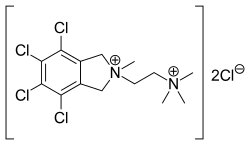Chlorisondamine
 | |
| Clinical data | |
|---|---|
| ATC code |
|
| Identifiers | |
| |
| CAS Number | |
| PubChem CID | |
| ChemSpider | |
| UNII | |
| ChEMBL | |
| Chemical and physical data | |
| Formula | C14H20Cl6N2 |
| Molar mass | 429.04 g/mol |
| 3D model (JSmol) | |
| |
| |
| | |
Chlorisondamine is a nicotinic acetylcholine receptor antagonist that produces both neuronal and ganglionic blockade.
Chlorisondamine has been shown to form noncovalent complexes with various biomolecules including sphingomyelin and other associated glycolipids.[1][2][3]
References
- ↑ Woods, A. S.; Moyer, S. C.; Wang, H. Y. J.; Wise, R. A., "Interaction of chlorisondamine with the neuronal nicotinic acetylcholine receptor". Journal of Proteome Research 2003, 2 (2), 207–212.
- ↑ Jackson, S. N.; Wang, H. Y. J.; Woods, A. S., "Direct tissue analysis of phospholipids in rat brain using MALDI-TOFMS and MALDI-ion mobility-TOFMS". Journal of the American Society for Mass Spectrometry 2005, 16 (2), 133–138.
- ↑ Woods, A. S.; Ugarov, M.; Egan, T.; Koomen, J.; Gillig, K. J.; Fuhrer, K.; Gonin, M.; Schultz, J. A., "Lipid/peptide/nucleotide separation with MALDI-ion mobility-TOF MS". Analytical Chemistry 2004, 76 (8), 2187–2195.
This article is issued from
Wikipedia.
The text is licensed under Creative Commons - Attribution - Sharealike.
Additional terms may apply for the media files.